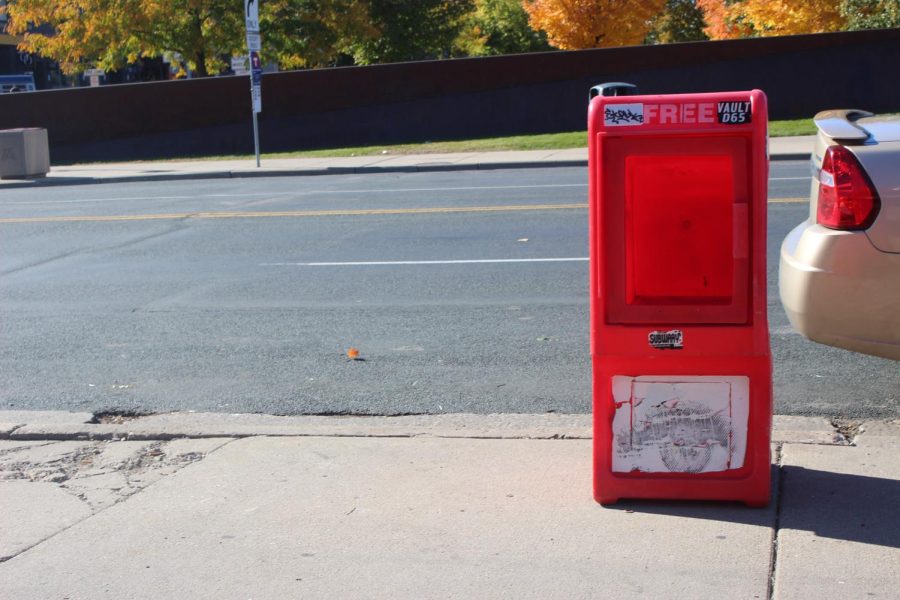Imagine you come across an article. Maybe a friend or family member posted it on social media, or maybe you came across it in a Google search. You don’t recognize the website it’s posted on, but it looks trustworthy. The name sounds like it could be a small local publication: St. Paul Reporter or North Hennepin News. These sites offer articles on local events, but also some more controversial topics, like critical race theory in schools.
Both of these sites are part of the Metric Media network. According to Priyanjana Bengani, the Tow computational journalism fellow at the Columbia Journalism School, this network contains 1200 sites. And, while Metric Media is by far the largest, there are similar networks of sites covering all 50 states and Washington D.C.
This is “pink slime” journalism. Ryan Zickgraf, the freelance journalist who coined the term, says he got the idea from a CBS report on cheap meat that had been treated with ammonia.
“They took just, like, you know, this low-grade gristle bone kind of thing and put it into what we would regularly think of as, like, hamburger,” he said.
For the record, I don’t know if pink slime is actually bad for you. ABC settled a lawsuit with a meat processing company that alleged their depiction of pink slime was defamatory. Settling a lawsuit usually isn’t an indication of guilt – but it’s not usually an indication of innocence, either. The U.S. Department of Agriculture says that it’s OK to label pink slime as “ground beef.” On the other hand, ammonia-treated meat is banned in Canada. Regardless, this column is about journalism, not meat, so I’ll continue to use the metaphor.
Back in 2012, around the time of those original news reports, Zickgraf was working for a company called Journatic. “The biggest expense in journalism is the labor that’s used to create it,” he said. “So this company Journatic came in and were like, ‘We’re gonna disrupt the industry.’”
But, what Journatic wasn’t saying was this disruption would be done by paying freelancers like Zickgraf and writers abroad low wages for poor work. “Often plagiarized word-for-word from press releases, that kind of thing,” he said.
So, the poor-quality writing produced by underpaid workers was the pink slime in this metaphor. It was then mixed into the high-grade meat: local newspapers. Zickgraf became a whistleblower and was interviewed on the public radio program This American Life.
Today, a new type of pink slime has emerged. “How it’s evolved is that, you know, in local journalism, the money isn’t really there anymore,” Zickgraf said. “Well, where’s the money? It’s in politics. So the new form of [pink slime] is partisan.”
Instead of sneaking low-quality articles by underpaid workers into local newspapers, the new pink slime sneaks partisan messaging into a package that’s disguised as trustworthy local news.
In fact, the founder of Journatic, Brian Timpone, oversees Metric Media, the operator of the two fake sites I highlighted at the beginning.
Bengani, the computational journalism fellow, said many of these sites cut and paste the same stories while filling in the locally relevant information. “One of the things that these folks have been doing has been using tabular data and writing template stories,” she said.
She used COVID-19 as an example. “The CDC was publishing data fairly frequently. They were publishing data once a day. Each day, you could break up the data into a million different formats and publish each of those million formats as a different independent story.”
You can see how this works on the two Twin Cities-area sites I highlighted. For example, very similar stories about homes that were sold in a particular week last September were published on each site, but one was for St. Paul and one for Orono.
Having local data points in their stories gives these sites a boost of credibility, Bengani said.
She also said Metric Media is by far the largest network, with the second-largest having about 50 sites.
These deceptive sites are proliferating on both sides of the political aisle. Bengani and Zickgraf both said left-leaning outlets have been getting in on the pink slime action as well.
Bengani said “it’s very hard” for someone who hasn’t spent time researching this to identify pink slime in the wild. “I think a little transparency on their side would go a really long way.”
One way to identify pink slime is to do a “gut check.” Bengani said news readers should “get a sense and feel, are they showing you the kinds of content your community wants to see?” She used the example of the Miami building collapse, which was an important story but one that got sparse coverage on pink slime sites.
“[Columbia Journalism Review] and the New York Times have spent a lot of time and effort to figure out how these sites are organized and the funding because it’s intentionally obscured,” Zickgraf said. Bengani worked on that research for the Columbia Journalism Review.
Pink slime doesn’t spread in a vacuum. The rise of this shady industry has everything to do with the decline in local news. As the business models of traditional local media become increasingly unworkable, partisan hacks are trying to fill the void.
Thankfully, in addition to the traditional newspapers that are still hanging on, new business models have helped legitimate local journalism stay alive.
Scott Libin used to be the news director for WCCO and is now a fellow at the Hubbard School of Journalism and Mass Communication at the University of Minnesota.
“Television has developed some new revenue streams, including something called retransmission consent, or retransmission fees, that have grown dramatically over the last decade or so and made up for a lot of this lost advertising,” Libin said. According to CNBC, retransmission fees have grown thanks to deals with cable providers as well as providers of live TV via the internet, such as YouTube or Hulu.
Written journalism has also sought out new ways of doing business. Zickgraf highlighted the Chicago Sun-Times recently went nonprofit and merged with WBEZ public radio. Here in Minnesota, we have multiple nonprofit online outlets, such as MinnPost and Sahan Journal.
In addition, there are some brave souls trying to make for-profit local news work. After the collapse of City Pages, four writers for that alt-weekly co-founded Racket, which shares a web developer with fellow startup Defector and makes money from subscriptions and ads, according to co-owner Jay Boller.
I hope these new ideas and business models can keep local journalism alive. But for now, be careful not to step in pink slime.




















